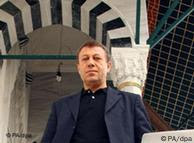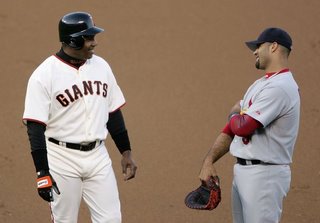 Uwe-Karsten Heye
Uwe-Karsten Heye, a spokesman in the government of former
German Social Democratic Party (SPD) chancellor
Gerhard Schröder,
set off a political tempest on Wednesday when he warned people of color visiting the country for the
2006 World Cup, which begins on June 9, not to venture into rural areas of eastern
Brandenburg State (the pale blue state on the right in the map at left), which surrounds the federal capital,
Berlin, because they might be attacked by
Neo-Nazis and other members of the German far right. He told
Deutschlandradio Kultur, "
There are small and mid-sized towns in Brandenburg and elsewhere where I would advise anyone with a different skin color not to go," and added quite dramatically, "
they may not leave with their lives."
Wolfgang Schäuble, the Interior Minister of Germany's current government, headed by the right-leaning
Christian Democratic Party (CDU) and chancellor
Angela Merkel, however, claimed that Germany would not "tolerate any form of extremism, xenophobia or anti-Semitism." His counterpart in Brandenburg State,
Jörg Schönbohm, asserted that visitors of all colors would feel "safe" and called for Heye to resign from his position a German anti-racist group,
Gesicht zeigen (Show Your Face), while the head of the tourism committee for the German parliament denied the Germany "was far from a country" where visitors should fear attacks from far rightists. The premier (governor) of Brandenberg,
Matthias Platzeck, a fellow SDU member, decried what he called Heye's "absurd slur of a whole region that is no way justifiable." Berlin's openly gay, Socialist mayor,
Klaus Wowereit, also claimed that visitors would be fine.
Yet there have been a rush of racist attacks that have set politicians and Germany's citizens on edge. Last month,
an Ethiopian-born German man was beaten so badly he remains in a coma; the attack occurred in
Potsdam, the capital of Brandenburg state. A few weeks ago, regional assemblyman
Giyasettin Sayan (below right, Deutsche Welle) who represents Berlin's
Lichtenberg district on the reconstituted-Communist
Left (Links) Party line,
was brutally attacked near his home by two men who called him a "dirty foreigner," and suffered head injuries severe enough that he had to be hospitalized.
 Just today
Just today, a spate of racially-motivated attacks occurred in eastern Germany: 6 people were attacked in Berlin, including a Turk, a Lebanese man, an Indian, and a Guinean. The police were able to arrest all or most of the attackers. In
Weimar, the country's capital from the end of World War I to Hitler's chancellorship, three Mozambicans and a Cuban man were injured when attackers burst into a private party and assaulted them. The police did arrest 8 suspects. In the eastern German city of
Wismar, an Indian man was beaten at a flea market. Yet things were localized solely in eastern Germany. In the western town of
Würzburg, nine people were detained after shouting Nazi slogans at a birthday party; any promotion or depiction of pro-Nazi iconography or rhetoric is officially illegal in Germany.
Germany's
Afrika-Rat (African Council) has published a list of "no-go" places in Brandenburg and other parts of the east for Black people and other people of color. Berlin political scientist
Yonas Endrias, a member of the Africa-Rat, ratified Heye's warning by noting that there were places in Brandenburg that he and other Black Germans wouldn't dare take their families, because while he averred that there was racism in western Germany, in the east Black people were more likely to be attacked.
The World Cup committee is set to publish an online guide to warn potential visitors about notorious racist hotspots. Between 2004 and 2005,
far-right crime in Germany rose by 28%, to more than 15,000 incidents, and of these, 958 were linked directly to Neo Nazis, a 24% increase.
Some figures in the German government, as well as in the German media and intellectual classes, believe that Heye's warning and the focus on the racial attacks are overblown. They also have suggested that Germany's extreme right-wing
National Democratic Party (NDP) is hoping to gain attention and support both inside and the country from the focus on a rise in far right activism and attacks. It also has planned to stage rallies at some of the World Cup matches, including the one between Angola and Iran, which it has said it will support because of Iranian president Mahmoud Ahmadinejad's comments against Israel.
The usual explanations for the far right activity in east Germany hinge on the harsh economic disparities that have existed since unification between this still-poor, job-challenged formerly Communist sector and the far wealthier western states that once constituted the Federal Republic of Germany; alongside the east's economic problems, those appraising the Neo-Nazi (and Nazi residue) problem cite the Easterners' issues with economic competition based on immigration, the lack of a liberal and plural democratic tradition (after 40 years of Communism), and the inadequacy of (or indifference by) the unified liberal government and liberalism as an ideology to address the racial and ethnic transformation of the country. Yet I would argue that these issues are as salient in western Germany and other parts of Europe as in Germany's eastern states. In addition, East Germany's particular educational approach to understanding the Nazi past also has received blame. In the BBC article, the
Simon Dubnow Institute for Jewish History and Culture at the University of Leipzig's Dr.
Frank Neseman attributes the presence of Neo-Nazism in Eastern Germany to the "authoritarian education systems under the communists...this kind of education was always based on ideas of hatred - anti-capitalism and against class enemies, Zionism, the US, West Germany," as if the long history of xenophobia, anti-Semitism, and racism and racialist thinking in Germany and Austria (and Europe more broadly), particularly on the political right, were also somehow not central. In addition to anti-Semitic appeals going back centuries, anti-Black and anti-foreign sentiment particularly took hold among the Austrian right at the end of the 19th century, and among the Germany right in the 1920s. One of the first governmental policies enacted after the Nazi takeover was the mass sterilization of
mixed-raced, especially part-African, children. In Western Germany, numerous former Nazi officials were permitted to serve in the post-War government, which created a smooth transition when the German economic miracle occurred, but did not lead to the sort of ideological break, at least beneath the surface, that did in fact occur in East Germany.
Post-unification economic problems in eastern Germany caused by the reordering of the economy and globalization certainly have fostered resentment against the west, foreigners and people of color, but neo-Nazi groups and far right parties also exist in western Germany (as today's news makes clear), as well as in neighboring countries with a strong economic performance, such as
Austria and
Belgium. Schäuble's and Schönbohm's denials and laissez-faire approach only contribute to the problem rather than helping to resolve it.
Speaking of Belgium,
the recent racist murder of an Malian-born woman and her child (
Oulemata Niangadou, 24, and
Luna Drowart, 2, were slain; a Turkish woman,
Songul Koca, was wounded in the attack) in Antwerp has caused national shockwaves, after Blacks and other people of color had been attacked recently in Brussels. Today, at a "White March" (?),
thousands marched through Antwerp's streets to protest the murder and the extremist
Vlaams Belang (Flemish Interest) party, to which the murderer was linked. Meanwhile,
a surge in racist attacks has plagued Russia, and, after the flareups last fall in
France, the leading figure in that country's "moderate" right,
Nicolas Sarkozy, has proposed
a sweeping, harsh anti-immigrant bill, now passed by the French lower house, that would find much favor among the GOP in the U.S. House of Representatives.




 Reading
Reading 







